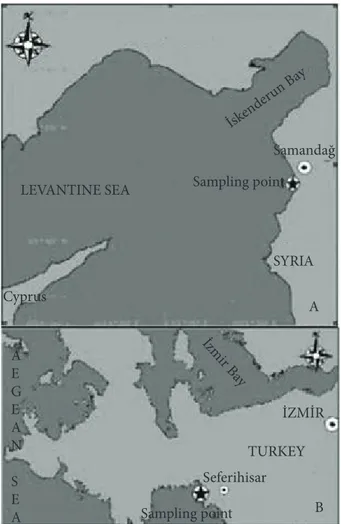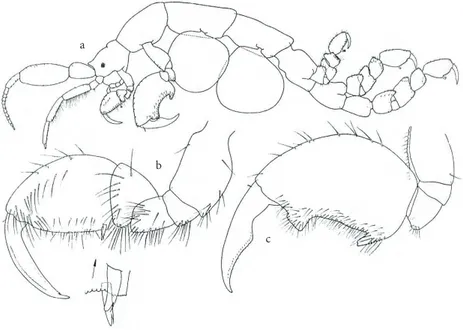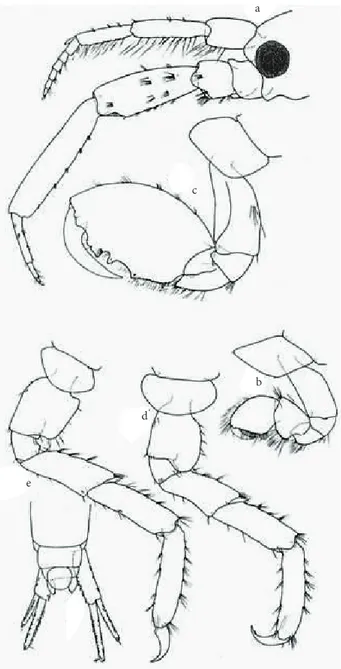Notes on amphipods Caprella andreae Mayer, 1890 and
Podocerus chelonophilus (Chevreux & Guerne, 1888)
collected from the loggerhead sea turtle, Caretta caretta,
off the Mediterranean and the Aegean coasts of Turkey
Murat SEZGİN1,*, A. Suat ATEŞ2, Tuncer KATAĞAN3, Kerem BAKIR3, Şükran YALÇIN ÖZDİLEK4 1Department of Marine Biology, Fisheries Faculty, Sinop University 57000 Sinop - TURKEY
2Department of Marine Biology, Fisheries Faculty, Çanakkale Onsekiz Mart University 17100 Çanakkale - TURKEY 3Department of Marine Biology, Fisheries Faculty, Ege University 35100 Bornova, İzmir - TURKEY
4Department of Biology Education, Education Faculty, Çanakkale Onsekiz Mart University 17100 Çanakkale - TURKEY
Received: 01.07.2008
Abstract:The present study reports the occurrence of 2 amphipod species, Caprella andreae Mayer, 1890 and Podocerus
chelonophilus Chevreux & Guerne, 1888, that appeared on the carapace of the loggerhead turtle Caretta caretta (Linnaeus,
1758) in the eastern Mediterranean Sea (Levantine Sea). The amphipod specimens were found on a male Caretta caretta captured during experimental bottom studies conducted off Samandağ, Hatay (the Turkish Mediterranean coast) on 7 April 2007. In addition, Caprella andreae Mayer 1890 was collected from the nets of fish cages off the Seferihisar (Aegean Sea) coast (38°11´32˝N, 26°38´07˝E). C. andreae is a first report for the amphipod fauna in Turkish seas.
Key words:Amphipod, Crustacea, sea turtle, epibiont, eastern Aegean Sea, eastern Mediterranean Sea, Turkey
Türkiye’nin Akdeniz ve Ege kıyılarında bir deniz kaplumbağasında rapor edilen
amfipodlar, Caprella andreae Mayer, 1890 ve Podocerus chelonophilus
(Chevreux & Guerne, 1888) üzerine notlar
Özet:Mevcut çalışma doğu Akdeniz’de (Levantin Denizi) dağılım gösteren iri deniz kaplumbağası, Caretta caretta (Linnaeus, 1758)’nın karapası üzerinde görülen iki amfipod türü, Caprella andreae Mayer, 1890; Podocerus chelonophilus Chevreux & Guerne, 1888’un varlığını rapor etmektedir. Amfipod bireyleri 07 Nisan 2007’de Samandağ, Hatay (Akdeniz’in Türkiye kıyıları) açıklarında yürütülen deneysel dip çalışması sırasında yakalanan Caretta caretta (Linnaeus, 1758)’nın üzerinden bulunmuştur. İlave olarak, amfipod, Caprella andreae Mayer 1890 Seferihisar (doğu Ege Denizi) (38°11´32˝N, 26°38´07˝E) kıyılarındaki balık kafeslerinin ağları üzerinden toplanmıştır. C. andreae Türkiye Denizleri amfipod faunası için yenidir.
Anahtar sözcükler:Amfipod, krustase, deniz kaplumbağası, epibiont, Ege Denizi, doğu Akdeniz, Turkey
doi:10.3906/zoo-0807-3
Introduction
Marine turtles provide a suitable substrate for diverse communities of epibionts, primarily on the carapace (Bjorndal, 2003). The loggerhead turtle,
Caretta caretta (Linnaeus, 1758), hosts the most
diverse epizoan assemblages among marine turtles (Kitsos et al., 2005). Several studies have dealt with the species composition of epibiont communities on
C. caretta in several localities in the Mediterranean
Sea and the Atlantic Ocean (Caine, 1986; Frazier et al. 1992; Kitsos et al. 2005; Pfaller et al., 2006); however, there are apparently no records of epibionts from sea turtles off Turkish coasts. Herein we report the occurrence of 2 amphipod species typical of C. caretta in the Levantine Sea and eastern Aegean Sea.
Materials and methods
The benthic biota of the Samandağ (Levantine Sea) and Seferihisar coasts (the eastern Aegean Sea) of Turkey were studied during 2006-2007. Off the Samandağ coast bottom trawling with a 22-mm codend mesh size was used during surveys conducted at depths between 10 and 25 m. The first sampling point (Figure 1a) was located off the Samandağ coast, Hatay (eastern Mediterranean Sea) at GPS coordinates 36°08´27˝N, 35°53´35˝E. The second sampling point (Figure 1b) was located off the Seferihisar coast of the Turkish Aegean Sea at GPS coordinates 38°11´32˝N, 26°38´07˝E. The collected materials were preserved in the Laboratory of Marine Biology of the University of Sinop, Turkey. Amphipods in the samples were identified to species level, based on descriptions by Ruffo (1993) and Krapp-Schickel (1993). Results SYSTEMATICS PHYLUM ARTHROPODA SUBPHYLUM CRUSTACEA ORDER AMPHIPODA FAMILY CAPRELLIDAE GENUS: Caprella Lamarck, 1801
Caprella andreae Mayer, 1890
Material examined.
Seventeen ♂♂ and 9 ♀♀. Mean ♂ length: 12 mm; mean♀ length: 11.7 mm, coast of Samandağ (Hatay), eastern Mediterranean, Turkey, GPS coordinates 36°08´27˝N, 35°53´35˝E, depth: 16 m, sandy substrate with meadow, Halophila stipulacea (Forskål) Ascherson. The dorsal surface of the male loggerhead turtle (C. caretta) had a curved carapace length and width of 77 and 70 cm, respectively, 07.04.2007, bottom trawl. Fourteen ♂♂ and 4 ♀♀. Mean ♂ length: 11.2 mm; mean♀ length: 11.2 mm, coast of Seferihisar (İzmir), Aegean Sea, Turkey, GPS coordinates 38°11´32˝N, 26°38´07˝E, on the nets of fish cages, 12.05.2007, picking by hand.
Description (male)
Head rostrum short and triangular. Antenna I peduncle articles 1-2 enlarged. Antenna II peduncle
İskender un B ay Samandağ LEVANTINE SEA A E G E A N S E A Cyprus Sampling point Sampling point Seferihisar SYRIA İZMİR İzmir B ay TURKEY A B
longer than antenna I peduncle, flagellum with long pectinate setae on ventral margin. Gills rounded (Figures 2 and 3a). Female antenna I peduncle not enlarged. Gnathopod I with weak carina, palm straight, with 2 spines proximally (Figure 3b). Gnathopod II inserted in the middle of pereonite II, basis carinate, palm proximal with a very prominent tooth, followed by a deep concavity, distally defined by a rounded process, dactyls short and wide, inner margin dentate (Figure 3c).
Ecology
Attached to floating objects on high sea: buoys, pieces of plants, wood, or pumice. Also found on the back of C. caretta and Chelonia (Krapp-Schickel, 1993).
General distribution
Atlantic Ocean, Pacific Ocean, and Mediterranean Sea.
PHYLUM ARTHROPODA SUBPHYLUM CRUSTACEA
ORDER AMPHIPODA FAMILY PODOCERIDAE GENUS: Podocerus Leach, 1814
Podocerus chelonophilus (Chevreux & de Guerne,
1888)
Material examined
Two ♂♂. Mean length: 4.5 mm, coast of Samandağ (Hatay), eastern Mediterranean, Turkey, GPS coordinates 36°08´27˝N, 35°53´35˝E, depth: 16 m, sandy substrate with meadow, Halophila stipulacea (Forskål) Ascherson, the dorsal surface of a male loggerhead turtle (C. caretta) 07.04.2007, bottom trawl.
Description (male)
Body smooth, very strong. Eyes large and round. Antenna II longer than antenna I. Antenna I peduncle art II longer than art III, flagellum of IV-VI arts slightly longer than peduncle art III. Antenna II strong, peduncle art IV longer than art IV. Antenna II
2 mm
2 mm
a
b
c
Figure 2. Lateral view of Caprella andreae (original).
with few small setae (Figures 4 and 5a). Gnathopod I strong, carpus very large, propodus subpyriform, palmar margin smooth (Figure 5b). Gnathopod II much stronger than gnathopod I, propodus oval elongate, palmar margin setose with a broad truncated lobe close to dactyl’s base, and a submedial triangular tooth (Figure 5c). Pereiopod V basis posterior margin convex (Figure 5d). Pereiopod VI basis posterior margin straight (Figure 5e). Uropod I-II inner ramus longer than outer, interior margin armed with numerous small, curved spines. Telson small and circular (Figure 5f).
Ecology
On turtles C. caretta and Chelonia, mostly under the tail and at base of the legs (Ruffo, 1993).
General distribution
Central Atlantic Ocean (Azores), Pacific Ocean, and Mediterranean Sea.
Discussion
At present, there is little information available about epibionts of sea turtles in Turkish seas. The present study reports 2 epibiont species found on a loggerhead sea turtle captured via bottom trawl. The first, C. andreae, belongs to a family of amphipods that are typical dwellers of many littoral biotopes, being particularly abundant in epibiotic fouling communities. Caprellids can firmly hold onto substrates using their last pereiopods. Pleopods, which are used for swimming in other amphipods, are reduced in caprellids; therefore, although caprellids can swim, they are probably not very efficient swimmers. This suggests that caprellids may be
passively dispersed by clinging to floating materials rather than by active swimming (Thiel et al., 2003). Krapp-Schickel (1993) noted that C. andreae is attached to floating objects—buoys, pieces of plants, wood, or pumice—but can also be found on the carapace of C. caretta and Chelonia mydas. As an epibiont of C. caretta, C. andreae have been reported in the Mediterranean Sea (Gramentz 1988; Badillo et
Figure 4. Dorsal view of Podocerus chelonophilus (original).
Figure 5. Appendages of a male Podocerus chelonophilus copied from Ruffo (ed.) 1993. a: Head; b: gnathopod I; c: gnathopod II; d: pereiopod IV; e: pereiopod VI; f: urosome and telson.
1 mm a c e d b
al., 2003, 2007; Kitsos et al., 2005; Badillo, 2007), as well as in the Atlantic (Caine, 1986; Frick et al., 1998) and Pacific (Aoki and Kikuchi, 1995) oceans.
P. chelonophilus is considered a specialist epibiont
of sea turtles observed on the carapace of turtles (Badillo et al., 2003; Badillo, 2007). Ruffo (1993) indicated that P. chelonophilus was found under the tail and on the base of the legs of turtles. Our study confirms that these amphipods also occur on the carapace surface of C. caretta. P. chelonophilus has
been reported in the Mediterranean Sea (Chevreux and De Guerne, 1888; Ruffo, 1993; Kitsos et al., 2005), as well as in the Atlantic (Thomas and Barnard, 1992; Moore, 1995; Frick et al., 1998) and Pacific (Baldinger, 2000) oceans.
Acknowledgements
The study was funded by the Scientific and Technological Research Council of Turkey (project TOVAG 10502107).
Aoki, M. and Kikuchi, T. 1995. Notes on Caprella andreae Mayer, 1890 (Crustacea: Amphipoda) from the carapace of Loggerhead Sea Turtles in the East China Sea and in Kyushu, Japan. Proceedings of the Japan Society of Systematic Zoology, 53: 54-61. Badillo, F.J., Aznar, F.J., Tomas, J. and Raga, J.A. 2003. Epibiont Fauna
of Caretta caretta in the Spanish Mediterranean. In: Margaritoulis, D. and Demetropoulos, A. (ed.). Proceedings of the First Mediterranean Conference on Marine Turtles. Barcelona Convention, Bern Convention, Bonn Convention (CMS). Nicosia, Cyprus, 62-66.
Badillo, F.J. 2007. Epizoitos y parasitos de la tortuga boba (Caretta
caretta) en el Mediterraneo Occidental. Ph.D. Thesis. Facultat
De Ciencies Biologiques. Univ Valencia, Spain. 262 pp. Baldinger, A.J. 2000. Notes on Podocerus chelonophilus (Chevreux y de
Guerne, 1888) (Crustacea: Amphipoda: Podoceridae) from a sea turtle off the coast of Ecuador. Pol. Arch. Hydrobiol., 47: 441-455.
Bjorndal, K.A. 2003. Roles of loggerhead sea turtles in marine ecosystems. In: Bolten, A.B. and Witherinton, B.E. (ed.). Loggerhead sea turtles. Washington DC. Smithsonian Books. pp. 235-254.
Caine, E.A. 1986. Carapace epibionts of nesting loggerhead sea turtles. Atlantic coast of USA. J. Exp. Mar. Biol. Ecol., 95: 15-26. Chevreux, E. and de Guerne, J. 1888. Sur un amphipode nouveau
(Cyrtophium chelonophilum), commensal de Thalassocaretta L. Comptes Rendus Academie des Sciences, Paris, 88:1-4. Frazier, J., Winston, J.E. and Ruckdeschel, C.A. 1992. Epizoan
communities on marine turtles. III. Bryozoa. Bull. Mar. Sci., 51: 1-8.
Frick, M.G., Williams, K.L. and Robinson, M. 1998. Epibionts associated with nesting loggerhead sea turtles (Caretta caretta) in Georgia, USA. Herpetological Review, 29: 211-214.
Gramentz, D. 1988. Prevalent epibiont sites on Caretta caretta in the Mediterranean Sea. Naturaleza Sicil., 12: 33-46.
Kitsos, M.S., Christodoulou, M., Arvanitidis, C., Mavidis, M., Kirmitzoglou, I. and Koukouras, A. 2005. Composition of the organismic assemblage associated with Caretta caretta. J. Mar. Biol. Ass. U.K., 85: 257-261.
Krapp-Schikel, G. 1993. Part 3. Caprellidae. In: Ruffo, S. (ed.). The Amphipoda of the Mediterranean. Mémoires de l'Institut Océanographique, Monaco, 13 (xxii-xxv): pp. 577-813. Moore, P.G. 1995. Podocerus chelonophilus (Amphipoda:
Podoceridae) associated with epidermal lesions of the loggerhead turtle, Caretta caretta (Chelonia). Journal of the Marine Biological Association of the United Kingdom, 75: 253-255.
Pfaller, B.J., Bjorndal, A.K., Reich, K.J., Williams, K.L. and Frick, M.G. 2006. Distribution patterns of epibionts on the carapace of loggerhead turtles, Caretta caretta. J. Mar. Biol. Ass. 2, Biodiversity Records, published online, 1-4.
Ruffo, S. 1993. Part 3. Podoceridae. In: RUFFO, S. (ed.). The Amphipoda of the Mediterranean. Mémoires de l'Institut Océanographique, Monaco. 13 (xxii-xxv): 577-813.
Thiel, M., Guerra-García, J.M., Lancelotti, D.A. and Vásquez, N. 2003. The distribution of littoral caprellids (Crustacea: Amphipoda: Caprellidea) along the Pacific coast of continental Chile. Rev. Chil. Hist. Natur., 76: 297-312.
Thomas, J.D. and Barnard, J.L. 1992. Podocerus kleidus, new species from the Florida keys (Crustacea, Amphipoda, Dulichiidae). Bull. Mar. Sci. 51: 309-314.


